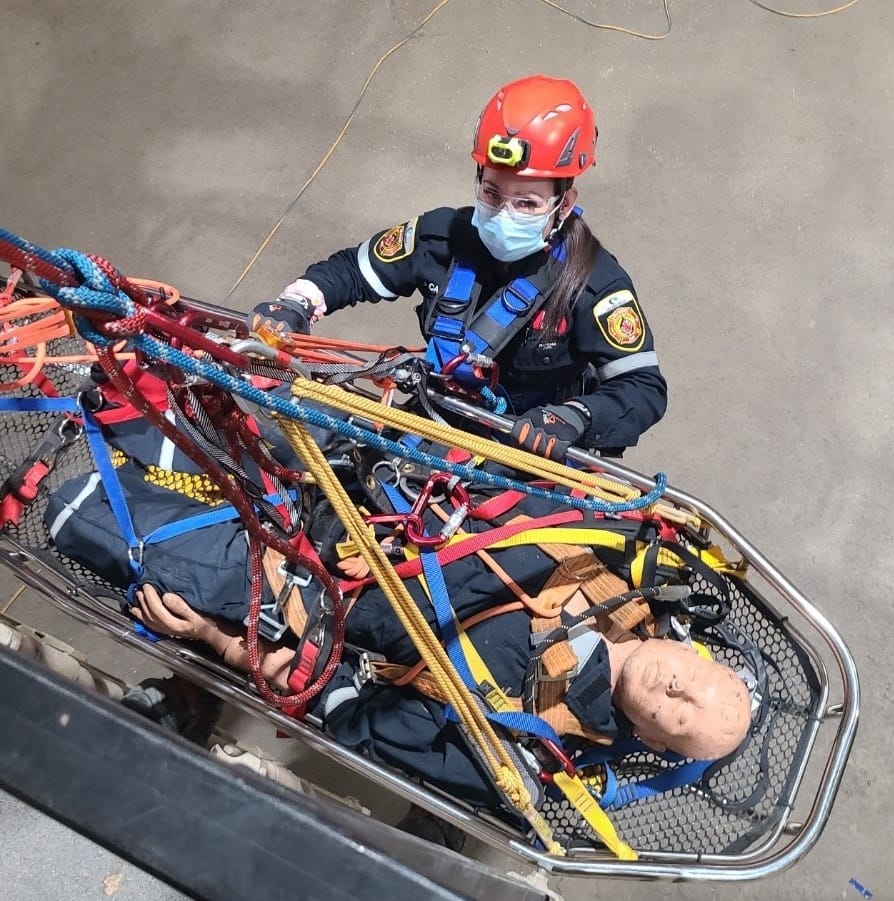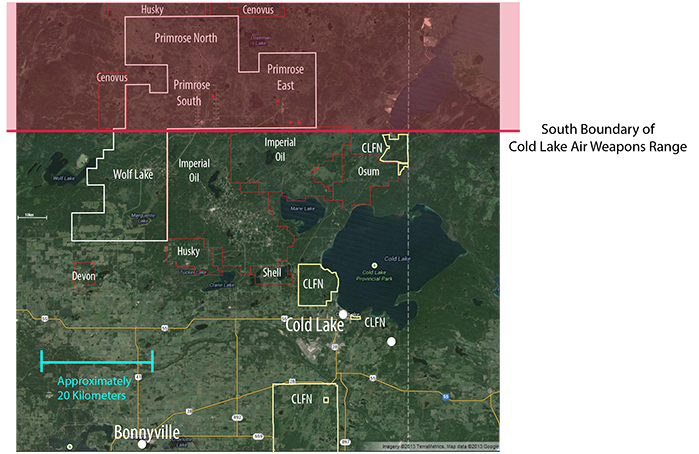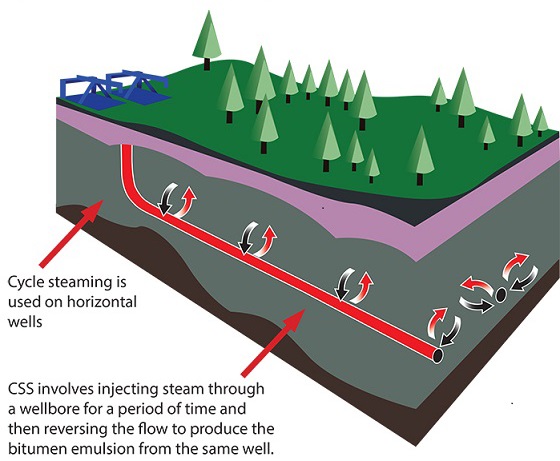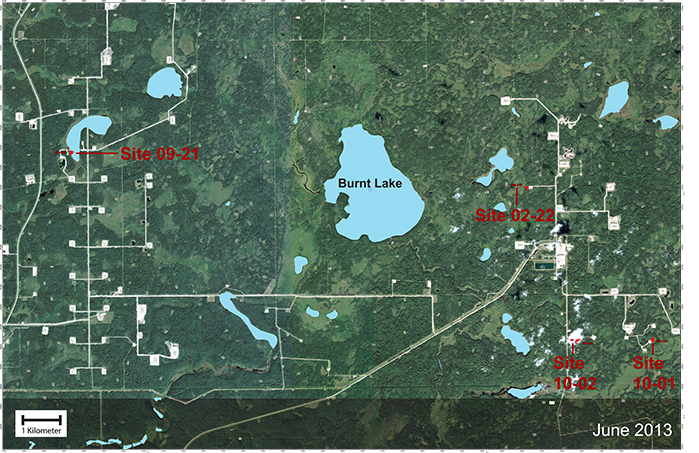Emergency Management
Proactive Risk Identification and Response
Canadian Natural is dedicated to operating in a proactive and safe manner to manage the potential risks associated with oil and natural gas operations. To do this, we focus on proactive risk management, from risk identification and mitigation to response across all our operations in Canada, offshore UK and Africa.
Our comprehensive emergency response approach across our operations ensures we are properly prepared for a safe and well-coordinated response to potential incidents. Our emergency response management includes an Incident Command System, detailed procedures, resources, training and Emergency Response Plans (ERPs) for immediate initial response and efficient management of a situation until it has been resolved or until other resources can be mobilized to the site.
As part of our continuous improvement efforts, we maintain a detailed ERP system and provide training to our teams each year, including participation of Health and Safety, Production and Development Operations personnel, regulatory bodies and partners — to maintain an effective state of readiness for emergencies at all operating sites.
Canadian Natural’s corporate emergency management program, including ERPs, meets the regulatory requirements in each jurisdiction where we operate, including the:
- Alberta Energy Regulator (AER)
- British Columbia Energy Regulator (BCER)
- Canada Energy Regulator (CER)
- Mining, Oil and Gas Branch – Regulatory Services/Oil and Gas Unit, Manitoba
- Environment and Climate Change Canada (ECCC)
- National Standards of Canada
- Office of the Regulator of Oil and Gas Operations (OROGO), Northwest Territories
- Saskatchewan Ministry of Energy and Resources (MER), Saskatchewan
Key Public Safety Information
Safety and Environmental protection are core values at Canadian Natural. Our goal is to be proactive and prevent facility and equipment failures to protect people, the environment, and the integrity of our assets. Our teams work closely to ensure that if an incident — such as leak or spill — occurs, the consequence is minimized through our Emergency Response Management program.
Protecting the environment
At Canadian Natural, we follow government regulations and industry operating practices, including the protection of the land, air and water sources. In the unlikely event of a spill, Canadian Natural has an extensive in-house inventory of spill response supplies and equipment strategically located at key locations for accessibility.
Activation of our Emergency Response Plan (ERPs) provides coordination and effective management of an incident by our trained personnel, while assistance from regional or national spill services provides long-term spill response recovery. Our ERPs provide contact information for additional resources to be mobilized to site. Our Incident Command System is applied to manage the spill response and clean up. Appropriate notifications are made as per our ERPs as regular communications with regulatory agencies and local authorities provide more effective and efficient response.
Procedures for the public in case of an emergency/incident
To protect people and the environment, Canadian Natural engages with all relevant stakeholders in proximity to our assets (pipelines, wells, facilities) to promote public awareness of our operations and, where necessary, ensure contact information is current. Public consultation programs are conducted to provide a Public Information Package (PIP) to stakeholders who are close to our assets and included in our ERPs. The PIP includes information on hazardous substance(s), associated risks, key company emergency numbers and contact information for local first responders, and municipal/jurisdictional provincial regulatory agencies. For residents within the ERPs, we also provide an area map and a brief description of Canadian Natural’s emergency response and public safety procedures, such as shelter-in-place and evacuation. A review of our plan is conducted annually, and residents within the ERP receive regular updates.
For people living adjacent or working in close proximity to pipelines, read more about working safely around pipelines to ensure your safety and the safety of others.
If you have any questions or need to communicate with Canadian Natural about a potential emergency or incident, please read the questions and answers below:
How can I inform Canadian Natural of an incident?
If you see an out-of-the-ordinary situation near one of our sites, we encourage you to call our 24 hour emergency number 1-888-878-3700. This number is prominently displayed at all Canadian Natural facilities and pipelines, as well as readily available in our PIPs and other documents used for consultation purposes, as well as on our website.
How am I notified in a Canadian Natural emergency?
If there is an emergency that could affect your safety, you will be notified by telephone or personal visit and provided with information and guidance as determined by our assessment of the situation. The advice given to you will depend on your location in relation to the incident and may involve sheltering in place or evacuation.
If contact cannot be made by the above means, a thorough survey of the area will be conducted by authorized personnel to ensure that all persons are advised of the emergency situation.
If an incident has the potential to impact the public at large, e.g. large communities, we will work with local municipalities/urban centres to ensure public safety. In these situations, assistance may be available from these agencies in the form of emergency equipment, road closures, house-to-house checks, Emergency Public Announcement system, and/or in a worst case situation, a Declaration of a Local State of Emergency.
How are municipal/provincial/federal agencies and first responders notified in an emergency?
If an emergency has been identified and confirmed as being a Canadian Natural operations incident, we will contact the local municipalities, health authorities and the RCMP and/or local police to ensure a coordinated and informed emergency response effort. When necessary, we will request the assistance of other key responders such as medical personnel and/or fire fighters.
To ensure all stakeholders including applicable provincial and federal agencies are notified and kept abreast of the situation, assigned Information and Liaison Officers will provide updates at regular intervals during the course of the incident.
What if I have questions during a Canadian Natural emergency?
As in any emergency situation, we ask that our dedicated 24-hour emergency number be kept clear to continue to serve as our main crisis line. During the course of an emergency situation, information will be posted on Canadian Natural’s website, including updates and media releases. Additionally, depending on the severity of the incident, an information hotline may be set up and posted on the website or a local public communications centre may be established to respond to direct inquiries. If you have questions regarding a particular incident and are not a member of the media, please access our website or information hotline if applicable. Members of the media may submit inquiries here.
Spill Preparedness and Emergency Response
Our systems encompass proactive risk identification, management and mitigation across all operations in Canada, offshore UK and Africa.
Our oil spill response structure is comprised of immediate response and regional resources. Our ‘tiered’ emergency response structure aligns with international standards and ensures the planned response reflects the spill risk. These Tiers include:
- Tier 1 – Local. Resources on-site control small releases or releases that disperse naturally and do not require onshore support. These resources include dedicated field support vessels/emergency response and recovery vessels, as well as dispersant spraying equipment, inflatable booms and skimmers for removing oil from the sea surface.
- Tier 2 – Regional. Larger releases that require support from a regional specialized contractor with support by our onshore Emergency Response teams in Aberdeen and Africa.
- Tier 3 – National. A major or large ongoing release requiring mobilization of onshore Emergency Response teams, and likely to require assistance at a national/international level. Tier 2 and 3 oil spill response capability is provided by our membership in Oil Spill Response Limited, with extensive oil spill response equipment at various locations around the world and mobilized globally using dedicated aircraft.
Emergency Response Exercises
As a key element of our robust emergency response management, interactive exercises reinforce our preparedness for effective emergency response. Training and planned exercises are completed for all Canadian and offshore operations. Exercises are designed to test the efficiency of our emergency response and supporting teams (first responders, regulators, families and media) to major environmental events using resources on a local (and national) basis. Tabletop exercises are carried out to review personnel response to certain scenarios in an informal setting, while ‘functional’ exercises involve corporate and external support functions that may be required in a real event.
In preparation for drilling, training sessions and exercises at our International operations also involve our drilling partners and evaluate the understanding of the different roles within an emergency scenario. In addition to tabletop exercises, ‘full scale’ exercises are carried out for our offshore installations and onshore support functions, including emergency response teams in Abidjan and Aberdeen, contractors’ emergency response teams, topside medical assistance providers, standby vessels and helicopter services.
Regional Emergency Response
Our Oil Sands Mining Emergency Services team provides first response capabilities 24 hours per day for medical, fire and rescue/technical operations. The services of our highly trained and specialized staff include: fire prevention, high angle rope rescue and confined space rescue, hazardous material spill response, surface water/ice rescue, aircraft rescue and firefighting, and tactical industrial firefighting. Our teams also develop and maintain Emergency Response Plans, provide training to staff, and certify that our life safety equipment is operationally ready at all times.
Canadian Natural is part of the Regional Mutual Aid Emergency Response Organization, a formal partnership in the Regional Municipality of Wood Buffalo with industry and the Fort McMurray Fire Department. The goal of the organization is to share common staff, equipment and resources in support of major emergency events, and to provide ongoing rapid response on and off-site, along highway 63 and to local communities as needed.

Emergency Procedure Manuals
Canadian Natural’s Corporate Emergency Response Plan (ERP) is designed to direct and coordinate personnel’s responses in the event of an incident.
This includes broader information such as Company response procedures, our Incident Command System, forms and guidelines, response roles and responsibilities, and general contact information. Canadian Natural’s Corporate ERP can be accessed here.
In addition to the Corporate ERP, site specific ERPs have also been prepared where required and are used in conjunction with the Corporate ERP by company personnel when responding to an incident. At minimum, all ERPs are reviewed and updated annually.
As per the Canada Energy Regulator Order AO-001-MO-006-2016, the site specific plans for the following facilities can be accessed below. Portions of the documents are not visible due to personal confidentiality and asset security guidelines. Canadian Natural assumes no responsibility for errors or omissions in these documents or for direct, incidental or consequential losses or damages that may result from the external use or duplication of this material.
Emergency Response Management Summary
Designed to provide a continuous cycle of improvement, our emergency response management consists of an extensive set of policies, procedures and processes. The following is a summary of its key components.
- 1. Policy and Commitment
- Corporate Statement on Health and Safety
- Corporate Statement on Environmental Management
- Corporate Statement on Asset Integrity Management
- 2. Goals and Objectives
To achieve Canadian Natural’s ultimate goal: ‘No harm to people and no safety incidents’, our emergency response management has four specific goals, each one supported by specific activities:
- Prevention
- Along with adherence to regulations, codes of practice and industry best practices, Canadian Natural focuses on safe, reliable and proactive operations through the integrated use of our comprehensive management systems, including, but not limited to: Safety Management System (SMS), Process Safety Management (PSM), Pressure Equipment Management Systems and Environmental Management System (EMS).
- Preparedness
- We engage and regularly consult with all stakeholders that are in proximity to our operations associated with site specific Emergency Response Plans (ERPs), including members of the public, local governments, first responders and health authorities, in order to identify and make available critical information such as potential hazards, emergency response procedures, contact information and roles and responsibilities.
- Internally, we regularly review our ERPs, conduct emergency response training sessions and exercises for all key personnel and parties involved, and maintain an extensive in-house inventory of spill response supplies and equipment. This inventory is strategically located at key locations for immediate response until other resources can be mobilized to site.
- Response
- We follow ERP activation requirements to ensure that all the necessary and appropriate actions are taken to resolve emergency situations, protect the public and workers and mitigate damage to the environment and property. This includes working in partnership with other stakeholders.
- Recovery
- Includes incident investigation, implementation of any necessary remediation, and sharing learnings within the company and industry as appropriate.
To effectively prevent and mitigate releases, Canadian Natural’s emergency management integrates a cross-section of Health and Safety, Asset Integrity, Security, Environment and Operations. Our teams work closely to ensure that if a leak or spill occurs, the consequence is minimized through our ERPs and spill preparedness programs.
- 3. Incident Management System
An incident management system is a standardized approach to emergency management that includes personnel, facilities, equipment, procedures and communications operating within a common organizational structure. Canadian Natural uses an Incident Command System (ICS) based on the standards set forth by ICS Canada. ICS provides a common hierarchy and an integrated organizational structure for all aspects of the response to enable effective and efficient incident management. The system brings together the functions of our company with federal and provincial governments, as well as local authorities and governments.
Key elements of any ICS include: organizational collaboration, flexible organization, integrated communications, consolidated incident action planning, unity of command and designated incident facilities.
- 4. Hazard Identification, Risk Assessment and Controls
At Canadian Natural, we focus on proactive risk management, from risk identification, assessment and monitoring, to mitigation and control across all our operations. Our integrated Emergency Management System has multiple safeguards in place to prevent spills, releases or other potential hazards from occurring.
We have systems in place which extend to a broad range of potential hazardous situations: from operational and process safety incidents (high vapour pressure pipeline releases, spills, fire and explosions, on-site chemicals or fuels) to severe weather and natural disasters (forest fires, floods, earthquakes, lightning strikes and landslides), emergencies (highway/railway, environment, aircraft transportation, or pandemics), communications failures, power outages and security breaches.
Our risk analysis process is supported by dispersion modeling software and an internationally recognized process hazard analysis software tool. These are used to predetermine emergency planning zones (EPZs) — areas surrounding facilities that require specific emergency response planning as mandated by regulatory guidelines. EPZs are plotted on our site specific ERP maps to provide a visual image of the risk areas in relation to structures, roadways and geographical elements such as waterways or water bodies. These areas are used to identify stakeholders who may be at the greatest risk and require consultation to ensure their awareness of the possible hazards and risks associated with our facilities/pipelines. Once the risk level of the hazard has been determined, emergency response preparedness controls are put in place to mitigate and address the potential consequences. These controls can include, but are not limited to, emergency equipment, clean-up resources, safety guidelines and mutual aid understandings. We periodically perform internal ERP audits, reviews and updates to ensure our emergency response information is compliant with regulatory requirements.
Canadian Natural’s monitoring and control systems are installed throughout our gathering system, including leak detection systems, emergency shut-down devices and other remote data monitoring systems. In the unlikely event of a spill, we have an extensive in-house inventory of spill response supplies and equipment strategically located at key locations for accessibility. For more information on these spill response arrangements, read the Spill Preparedness and Emergency Response section.
- 5. Stakeholder Liaison to Prepare for Emergencies
To ensure efficient communication and coordination during an emergency, we proactively conduct annual consultations with key stakeholders impacted by our operations — local municipalities, urban centres, health authorities and other first responders — in order to:
- Confirm and collect key contact information;
- Identify and clarify roles and responsibilities;
- Inform the agency of Canadian Natural practices and procedures, potential hazards and risk controls and mitigation; and
- Explore possible mutual aid options.
Our annual consultations are generally conducted by telephone, electronically or one-on-one meetings. Information collected during this process is incorporated into our Emergency Response Plans along with required provincial and federal authority Incident Reporting information.
To learn more about our work with stakeholders and what to do in case of an emergency, please read our Public Safety information section.
- 6. Continuing Education
Canadian Natural maintains ongoing communication with local disaster services and health authorities, other organizations and agencies, as well as the public living near our operations. The information we share includes the location of our operations, potential hazards, potential emergency situations involving a pipeline, and safety procedures in the case of an emergency. In addition to our Public Information Package, which provides guidance on what to do in an emergency and who to contact, our Government Agency Consultation Forms also provide safety procedures and information. These forms include scene arrival protocols, chemical hazards and liaison guidelines, and they also serve to collect emergency contact information. All documents are provided every year to the communities, and more frequently if required during changes in operations, such as new facilities or an acquisition.
Our Safety Management System adds to our focus on continuous education of safety procedures by mandating the use of hazard assessments and safety orientations for all persons attending Canadian Natural sites, including those attending as a result of an emergency. When appropriate, we also conduct public meetings and targeted information sessions to ensure stakeholders are aware of our operations and emergency management policies.
- 7. Training and Exercises
In addition to a continuing education program, Canadian Natural maintains a rigorous emergency response training and exercise schedule for our employees and contractors to maintain an effective state of readiness for emergencies at all operating sites. Training and exercises are mandatory for all levels in the company, from field operations to senior management, and exercises involve the participation of Health and Safety, Production and Development Operations personnel. Exercises are held at minimum on an annual basis and may consist of presentations or mock simulations.
To ensure a coordinated response to any emergency, local municipalities/urban centres, health region authorities, RCMP and/or local police and applicable regulatory agencies (e.g. CER, AER, BCOGC) are invited to attend and participate in our major exercises.
Our training methods consist of ‘hands-on’ training, including lectures, coaching, discussions, simulations and role playing.
Emergency management training at Canadian Natural takes place both in Calgary and field locations. It includes many elements as identified in our corporate ERP including, but not limited to:
- Our Incident Command System;
- Emergency response roles and responsibilities;
- Emergency response tools including the “10 Steps for Emergency Response”, First Responder’s Guide, Emergency Response Guide, Incident Command Flowchart, Emergency Notification Details chart, Emergency Time Action Logs, and many more;
- Where to find forms, scripts and specific guidelines;
- Where to find stakeholder contact information.
For more information on our exercises, read our Spill Preparedness and Emergency Response section.
Primrose Flow to Surface
As per the Alberta Energy Regulator’s requirements under Environmental Protection Order 2013-33/NR, section 40(a through f), Canadian Natural has posted the monthly updates for the dewatering, monitoring and maps, photographs, communication summaries, fish and fish habitat and wetland impacts of the unnamed water body included in the 2013 flow to surface event.
Canada has the world’s third largest oil reserves and approximately 97 per cent of those oil reserves are located in Alberta’s oil sands.
Canada’s oil sands are found in three deposits; the Athabasca, Peace River, and Cold Lake areas in Alberta and part of Saskatchewan. The greatest quantity is found in the Athabasca deposit near Fort McMurray where the oil sands are closer to the surface than in other regions.
Bitumen from oil sands is recovered using two main methods: open-pit mining and thermal in situ. The method applied depends on how deep the reserves are deposited. When bitumen is too deep (>80m) to economically mine, wells are drilled and produced through in situ methods (where heat is injected to reduce the viscosity and allow the bitumen to be pumped to surface facilities). In Alberta, 80 per cent of oil sands reserves could be recovered using in situ methods.
Primrose and Wolf Lake In Situ
Primrose/Wolf Lake Oil Sands Project (PAW) is a thermal in situ operation located approximately 65 km north of Bonnyville and about 350 km northeast of Edmonton, primarily inside the Cold Lake Air Weapons Range. The approved project area covers 288 sections or 73,728 hectares.

The majority of bitumen produced from the PAW area is from the Clearwater Formation.
The main process used to recover bitumen at PAW is cyclic steam stimulation (CSS) (shown below). CSS uses a single wellbore to inject steam and subsequently produce bitumen in the form of a water/bitumen emulsion. No chemicals are used.
Cyclic Steam Stimulation (CSS)

2013 Flow to Surface
In May and June of 2013, Canadian Natural discovered four locations with bitumen emulsion at surface within PAW. At one of the locations described as site 9-21, the flow to surface occurred below a small, unnamed water body. The other three sites, 2-22, 10-1, and 10-2 are terrestrial sites.

Canadian Natural has fully cleaned up the flow to surface sites and, on April 1, 2015, we submitted an extensive technical review into the cause of the flow to surface events to the Alberta Energy Regulator (AER). The AER released a final report on March 21, 2016 which is consistent with Canadian Natural’s findings. More details about Canadian Natural’s Final Report are available below.
As a result of extensive data gathering, investigation, analytical analysis and interpretation, Canadian Natural and the industry’s understanding of cyclic steam processes has been enhanced. These learnings have been applied, and our operational practices and strategies have been modified to mitigate the risk of future seepages.
Previous updates about the incident and our response are detailed below.